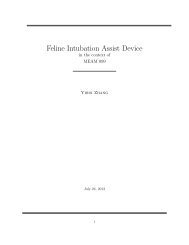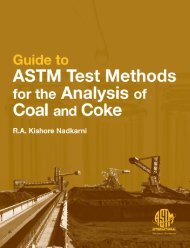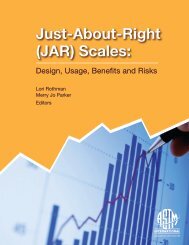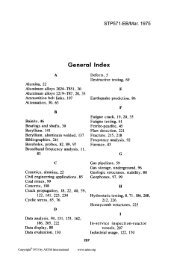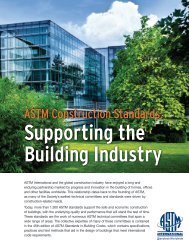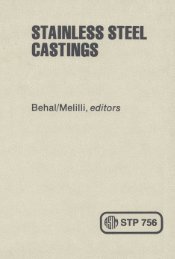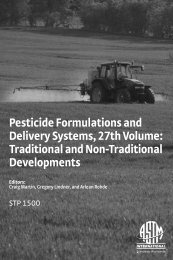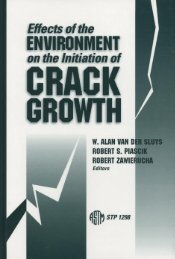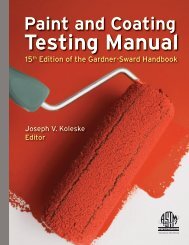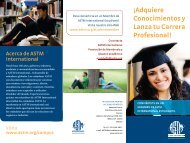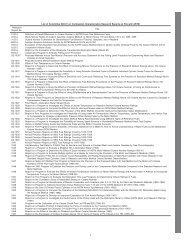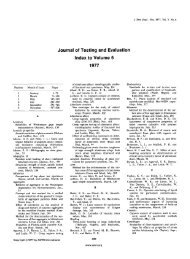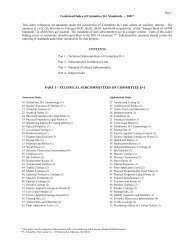Form and Style for ASTM Standards - ASTM International
Form and Style for ASTM Standards - ASTM International
Form and Style for ASTM Standards - ASTM International
Create successful ePaper yourself
Turn your PDF publications into a flip-book with our unique Google optimized e-Paper software.
PART A<br />
FORM OF <strong>ASTM</strong> TEST METHODS<br />
INTRODUCTION<br />
An <strong>ASTM</strong> test method, as defined on p. vii, typically includes a concise description of an orderly<br />
procedure <strong>for</strong> determining a property or constituent of a material, an assembly of materials, or a product.<br />
The directions <strong>for</strong> per<strong>for</strong>ming the test should include all of the essential details as to apparatus, test<br />
specimen, procedure, <strong>and</strong> calculations needed to achieve satisfactory precision <strong>and</strong> bias.<br />
An <strong>ASTM</strong> test method should represent a consensus as to the best currently available test procedure<br />
<strong>for</strong> the use intended. It should be supported by experience <strong>and</strong> adequate data obtained from cooperative<br />
tests.<br />
In order to be the “best currently available,” test methods need periodic review to determine whether<br />
revisions are desirable as the result of technological advances in manufacturing, testing, <strong>and</strong> use<br />
requirements.<br />
<strong>ASTM</strong> test methods are frequently intended <strong>for</strong> use in the buying <strong>and</strong> selling of materials according<br />
to specifications <strong>and</strong> there<strong>for</strong>e should provide such precision that when the test is properly per<strong>for</strong>med by<br />
a competent operator the results will be found satisfactory <strong>for</strong> judging the compliance of the material<br />
with the specification. These test methods cover the determination of fundamental properties of materials<br />
such as density, absolute viscosity, softening point, <strong>and</strong> flash point. They may include a variety of<br />
different laboratory procedures such as chemical <strong>and</strong> spectrochemical analyses, mechanical <strong>and</strong><br />
electrical tests, weathering tests, visual examination, fire tests, per<strong>for</strong>mance characteristics, sampling,<br />
nondestructive tests, <strong>and</strong> radiation exposure tests. In some st<strong>and</strong>ards, optional test methods are included.<br />
Statements addressing precision <strong>and</strong> bias are required in <strong>ASTM</strong> test methods. This gives the user of<br />
the test method an idea of the nature of the sample to be prepared <strong>and</strong> analyzed <strong>and</strong> in<strong>for</strong>mation<br />
regarding the nature of the data obtained by using the method. The requirement of precision <strong>and</strong> bias<br />
statements does not mean that numerical statements are required. It means that the spread of resulting<br />
data <strong>and</strong> its relationship to an accepted reference material or source (if available) shall be addressed.<br />
Some test methods have no numerical expression of precision or bias (<strong>for</strong> example, pass/fail tests, spot<br />
tests.) In these cases, precision <strong>and</strong> bias shall be addressed <strong>and</strong> the reasons <strong>for</strong> not including relevant data<br />
explained. Test methods are sometimes prepared <strong>for</strong> use in research rather than in the buying <strong>and</strong> selling<br />
of materials. Other test methods cover process control, screening, <strong>and</strong> field tests. Although these latter<br />
test methods may not always be as precise as referee test methods, they are sufficiently precise <strong>for</strong> the<br />
intended use <strong>and</strong> usually require less time. Field tests allow testing at the site, thus eliminating<br />
transportation of specimens to <strong>and</strong> from the laboratory.<br />
Special instructions with respect to the legal aspects are included in Part F <strong>and</strong> shall be followed in<br />
writing any st<strong>and</strong>ard. These include such matters as contractual items, caveat statements, patents, <strong>and</strong> fire<br />
st<strong>and</strong>ards. Assistance on the development of fire st<strong>and</strong>ards is available from Committee E05. The<br />
policies contained in Part F are approved by <strong>and</strong> are under the jurisdiction of the <strong>ASTM</strong> Board of<br />
Directors.<br />
When a st<strong>and</strong>ard is being developed, the costs associated with its development <strong>and</strong> subsequent use<br />
generally should be considered. The prime objective should be the optimum use of resources to achieve<br />
satisfactory definition of the product or service. However, it should be noted that when the st<strong>and</strong>ard<br />
relates to the safety of persons, cost considerations are likely to become much less important than when<br />
attributes of materials or products are involved. Some st<strong>and</strong>ards, such as definitions, impose no cost on<br />
the user; others that include numerous <strong>and</strong> extensive requirements can entail significant expense to users<br />
of the st<strong>and</strong>ard. The requirements to be included should, there<strong>for</strong>e, be those that are technically relevant<br />
<strong>and</strong> yield benefits commensurate with the cost of their determination.<br />
A-1



